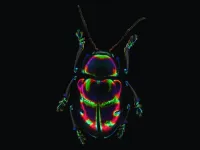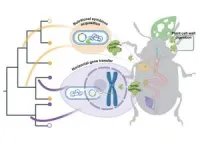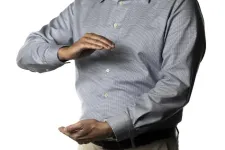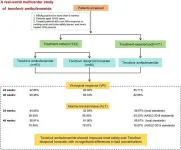(Press-News.org) With more than 50,000 described species, the leaf beetle family is distributed worldwide and represents about a quarter of the species diversity of all herbivores. Leaf beetles can be found to feed on almost all plant groups. They live in the rhizosphere, the canopy and even underwater. Many leaf beetles, such as the Colorado potato beetle, are notorious pests. Their species richness and global distribution highlight their evolutionary success, which is particularly astonishing given that leaves are a difficult food source to digest and provide unbalanced nutrients.
Researchers from the Department of Insect Symbiosis at the Max Planck Institute for Chemical Ecology in Jena and the Mutualisms Research Group at the Max Planck Institute for Biology in Tübingen, Germany, have now asked how leaf beetles have overcome these dietary challenges throughout evolution. Do different leaf beetle species use the same strategy, or have they found other ways to achieve their nutritional goal?
Understanding the role of foreign genetic material
Almost all leaf beetles have incorporated foreign genetic material into their genome, which is responsible for the production of enzymes necessary to digest plant cell wall components. For example, pectinases are enzymes that break down pectins – indigestible dietary fibers for humans, but metabolized by many bacteria. Approximately half of the species of leaf beetles live in close association with symbiotic bacteria. These symbionts provide the beetles with important digestive enzymes to help them break down food components. They often also provide the beetles with vitamins and essential amino acids.
The researchers know from their own previous studies that the beetles use both pectinases from their own genome and those encoded by symbionts. "These digestive enzymes are essential for the beetles' survival. However, we only have a fragmentary understanding of which beetle species need symbiotic bacteria for digestion, which do not, and where the beetles' pectinases come from. We wanted to reconstruct the evolutionary scenarios that led to today's distribution patterns through comparative studies of all leaf beetle groups," explains first author Roy Kirsch.
With the support of national and international colleagues, the team carried out genome and transcriptome analyses of 74 leaf beetle species from around the world. Through this comparative analysis across all leaf beetle subfamilies, the researchers could understand how the current distribution of the beetle's enzymes and symbiont-encoded enzymes has evolved. "We were also able to demonstrate that horizontal gene transfer, a phenomenon that describes the incorporation of foreign genes from bacteria into the genome, is quite common in leaf beetles. Both symbiosis and horizontal gene transfer have strongly influenced the evolution of insects," says Roy Kirsch.
Dynamic evolution of pectinases
The analyses also revealed that the vast majority of the beetle species use either their own pectinases, acquired through horizontal gene transfer, or the pectinases of their bacterial symbionts. However, beetle and symbiont pectinases never occurred together in any beetle species.
“The binary distribution of beetles encoding pectinases within their genomes versus those acquiring them symbiotically remains one of the most striking findings from the study. Such a pattern raises additional questions concerning how horizontal gene transfer and symbiosis have shaped the way beetles consume and process foliage, and the trade-offs associated with outsourcing a key metabolic trait,” explains Hassan Salem, who leads the Max Planck Research Group on Mutualisms.
The results of the study show that the evolution of pectinases is dynamic and characterized by the alternation of horizontal gene transfer and symbiont uptake. “You can imagine this process as follows: When a symbiosis is established, a beetle pectinase from a previous horizontal gene transfer is replaced by a symbiont pectinase. The advantage of incorporating a symbiont is that its pectinase may have new activities or be more efficient, and the symbiont may also provide additional benefits, such as producing other digestive enzymes or essential nutrients. The beetle's own pectinase gene is no longer needed and is lost during evolution. As the symbiotic interaction progresses, the symbiont's pectinase gene may be transferred into the beetle's genome and the symbiont may be lost, but this process needs to be studied in more detail,” says Martin Kaltenpoth, head of the Department of Insect Symbiosis.
A pathway to evolutionary success
The results show how repeated horizontal gene transfer and the establishment of symbioses with bacteria enabled leaf beetles to rapidly adapt to a plant-based diet, contributing to their remarkable evolutionary success.
END
Reading the genome and understanding evolution: Symbioses and gene transfer in leaf beetles
How leaf beetles found the key to digesting plants better with the help of bacteria
2025-01-17
ELSE PRESS RELEASES FROM THIS DATE:
Brains of people with sickle cell disease appear older
2025-01-17
Individuals with sickle cell disease – a chronic illness where misshapen, sticky blood cells clump together, reducing oxygen delivery to organs – are at a higher risk for stroke and resulting cognitive disability. But even in the absence of stroke, many such patients struggle with remembering, focusing, learning and problem solving, among other cognitive problems, with many facing challenges in school and in the workplace.
Now a multidisciplinary team of researchers and physicians at Washington University School of Medicine in St. Louis has published a study that helps explain how the illness might affect cognitive performance ...
Elena Belova and Yevgeny Raitses recognized for groundbreaking plasma physics research
2025-01-17
The diversity of plasma research at the U.S. Department of Energy’s (DOE) Princeton Plasma Physics Laboratory (PPPL) was readily apparent when the PPPL 2024 Distinguished Research Fellows were recently announced. Elena Belova and Yevgeny Raitses were awarded the honor at the Lab’s annual State of the Laboratory event. Belova, a theoretical physicist, won for her work developing highly complex simulations of plasmas in different fusion experiments. Raitses, a managing principal research physicist, was honored for his experimental work on ...
SOX9 overexpression ameliorates metabolic dysfunction-associated steatohepatitis through activation of the AMPK pathway
2025-01-17
Background and Aims
The transcription factor sex-determining region Y-related high-mobility group-box gene 9 (SOX9) plays a critical role in organ development. Although SOX9 has been implicated in regulating lipid metabolism in vitro, its specific role in metabolic dysfunction-associated steatohepatitis (MASH) remains poorly understood. This study aimed to investigate the role of SOX9 in MASH pathogenesis and explored the underlying mechanisms.
Methods
MASH models were established using mice fed either a methionine- and choline-deficient (MCD) diet or a high-fat, high-fructose diet. To evaluate the effects of SOX9, hepatocyte-specific SOX9 deletion or overexpression was performed. ...
Florescent probes illuminate cholesterol and Alzheimer’s research
2025-01-17
The search for answers to Alzheimer’s disease and other neurodegenerative disorders remains one of the most pressing goals in brain research. Maciej J. Stawikowski, Ph.D., an assistant professor of chemistry and biochemistry at Florida Atlantic University’s Charles E. Schmidt College of Science, believes the key may lie in understanding how cholesterol and other lipids move through cells and affect their communication.
“It’s well known that lipids and Alzheimer’s are linked,” said Stawikowski, a member of the FAU Stiles-Nicholson Brain Institute. “Lipid imbalance may ...
Qigong significantly decreases chronic low back pain in US military veterans
2025-01-17
Chronic pain is widespread in the United States, particularly among military veterans, affecting between 40 to 70% of this population and serving as a leading cause of disability. Veterans experience chronic pain more often than civilians, with back pain being the most common. Up to 75% of older veterans report chronic pain, while younger veterans and those from recent conflicts face more severe pain.
Chronic low back pain in veterans affects not only physical health but also social and occupational functioning, often leading to job ...
New insights into pancreatic disease and diabetes
2025-01-17
Cystic fibrosis (CF) is a life-threatening genetic disease affecting multiple organ systems, with pancreatic dysfunction representing a critical and often overlooked complication. A groundbreaking study published in eGastroenterology introduces young rabbits with CF as a novel and accessible model to study CF-related pancreatic endocrine pathology. This model offers an unprecedented opportunity to deepen our understanding of CF-related diabetes (CFRD), a condition affecting up to 50% of adults with CF.
CF is caused by mutations in the CF transmembrane conductance regulator (CFTR) gene, ...
Effectiveness and safety of tenofovir amibufenamide in the treatment of chronic hepatitis B: A real-world, multicenter study
2025-01-17
Background and Aims
Chronic hepatitis B (CHB) remains a significant global health challenge, and effective antiviral therapies are essential for long-term management. This study aimed to evaluate the real-world effectiveness and safety of tenofovir amibufenamide (TMF) in a cohort of patients with chronic hepatitis B (CHB).
Methods
In this multicenter, prospective, real-world cohort study, 194 CHB patients were recruited from four hospitals between August 2021 and August 2022. Patients were divided into treatment-naïve (TN, n = 123) and ...
Higher costs limit attendance for life changing cardiac rehab
2025-01-17
Despite the success cardiac rehabilitation has shown at reducing heart-related deaths and hospital readmissions, higher out-of-pocket costs may prevent patients from participating in the program, a Michigan Medicine study suggests.
In a national study of over 40,000 people with Medicare and commercial insurance, 81.6% of patients did not have to pay for their initial cardiac rehabilitation session.
The medically supervised program lasts up to 36 sessions, which are often recommended for patients recovering from many conditions and procedures.
Among ...
Over 500 patients receive diagnosis through genetic reanalysis
2025-01-17
European consortium for Solving the Unsolved Rare Diseases demonstrates the significance of international collaboration to address the unmet medical needs on rare diseases’ diagnosis
More than 500 European patients with unknown conditions have received a diagnosis through new genetic research. This includes patients with rare neurological disorders, severe intellectual disabilities, muscle diseases, and hereditary gastrointestinal cancer. These diagnoses were achieved through extensive European collaboration, led by researchers from the University of Tübingen, Radboud university medical center, and the National Center ...
Brain changes in Huntington’s disease decades before diagnosis will guide future prevention trials
2025-01-17
Subtle changes in the brain, detectable through advanced imaging, blood and spinal fluid analysis, happen approximately twenty years before a clinical motor diagnosis in people with Huntington’s disease, finds a new study led by UCL researchers.
The research, published in Nature Medicine, was in collaboration with experts at the Universities of Glasgow, Gothenburg, Iowa, and Cambridge.
The team found that although functions such as movement, thinking or behaviour remained normal for a long time before the onset of symptoms in Huntington’s disease, subtle changes to the brain were taking place up to two decades earlier.
These findings pave the way for ...
LAST 30 PRESS RELEASES:
Tracing the quick synthesis of an industrially important catalyst
New software sheds light on cancer’s hidden genetic networks
UT Health San Antonio awarded $3 million in CPRIT grants to bolster cancer research and prevention efforts in South Texas
Third symposium spotlights global challenge of new contaminants in China’s fight against pollution
From straw to soil harmony: International team reveals how biochar supercharges carbon-smart farming
Myeloma: How AI is redrawing the map of cancer care
Manhattan E. Charurat, Ph.D., MHS invested as the Homer and Martha Gudelsky Distinguished Professor in Medicine at the University of Maryland School of Medicine
Insilico Medicine’s Pharma.AI Q4 Winter Launch Recap: Revolutionizing drug discovery with cutting-edge AI innovations, accelerating the path to pharmaceutical superintelligence
Nanoplastics have diet-dependent impacts on digestive system health
Brain neuron death occurs throughout life and increases with age, a natural human protein drug may halt neuron death in Alzheimer’s disease
SPIE and CLP announce the recipients of the 2025 Advanced Photonics Young Innovator Award
Lessons from the Caldor Fire’s Christmas Valley ‘Miracle’
Ant societies rose by trading individual protection for collective power
Research reveals how ancient viral DNA shapes early embryonic development
A molecular gatekeeper that controls protein synthesis
New ‘cloaking device’ concept to shield sensitive tech from magnetic fields
Researchers show impact of mountain building and climate change on alpine biodiversity
Study models the transition from Neanderthals to modern humans in Europe
University of Phoenix College of Doctoral Studies releases white paper on AI-driven skilling to reduce burnout and restore worker autonomy
AIs fail at the game of visual “telephone”
The levers for a sustainable food system
Potential changes in US homelessness by ending federal support for housing first programs
Vulnerability of large language models to prompt injection when providing medical advice
Researchers develop new system for high-energy-density, long-life, multi-electron transfer bromine-based flow batteries
Ending federal support for housing first programs could increase U.S. homelessness by 5% in one year, new JAMA study finds
New research uncovers molecular ‘safety switch’ shielding cancers from immune attack
Bacteria resisting viral infection can still sink carbon to ocean floor
Younger biological age may increase depression risk in older women during COVID-19
Bharat Innovates 2026 National Basecamp Showcases India’s Most Promising Deep-Tech Ventures
Here’s what determines whether your income level rises or falls
[Press-News.org] Reading the genome and understanding evolution: Symbioses and gene transfer in leaf beetlesHow leaf beetles found the key to digesting plants better with the help of bacteria








